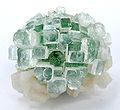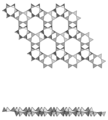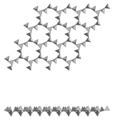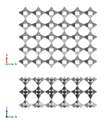Layered silicates
As layer silicates (also sheet silicates , phyllosilicates ) is defined as silicates , which silicate anions of layers of corner-sharing SiO 4 - tetrahedron consist. These layers or double layers are not linked to one another via further Si-O bonds to form frameworks.
This department of silicates includes important groups of rock-forming minerals such as B. the mica group , chlorite group , kaolin and serpentine group . The omnipresent in cohesive soils and in sedimentary rocks widespread clay minerals are also phyllosilicates, which are also technically important.
The layer-like structure of these minerals determines the shape and properties of the crystals. They are usually tabular to leafy with good to perfect cleavage parallel to the layers. The number of rings that make up the silicate layers often determines the symmetry and shape of the crystals. Apophyllite (layers of rings of four) is tetragonal and forms four-sided tabular to prismatic crystals. The minerals of the mica group (silicate layers made of six rings) form tabular to leafy crystals with pseudo-hexagonal symmetry. The good translational ability along the layers results in the high deformability of the layered silicates. H 2 O molecules and large cations can be stored between the layers . Layered silicates are often swellable and, with their cation exchange capacity, are important for the fertility of soils .
classification
Silicate classification according to Liebau
Liebau regards the layered silicates as a connection of silicate chains to form layers that are unlimited in two dimensions and subdivides the layered silicates on the basis of the periodicity and branching of the silicate chains that build up the layers and the multiplicity of the silicate layers.
Periodicity:
It indicates after how many silicate chain links (SiO 4 - tetrahedron) the structure of a chain repeats itself. The periodicity of natural sheet silicates is usually small and is 2 ( mica group ), 3 (e.g. dalyite ), 4 (e.g. apophyllite ) or 6 (e.g. pyrosmalite ).
Unbranched two single layer in muscovite
Unbranched two single layer in sepiolite
Unbranched three single layer in dalyite
Unbranched four single layer in apophyllite
Unbranched six-layer single layer in pyrosmalite
Branch:
It indicates whether further SiO 4 tetrahedra branch off from a silicate chain . A distinction is made between openly branched phyllosilicates (e.g. zeophyllite ) and cyclically branched phyllosilicates (e.g. Delhayelite ), in which the SiO 4 tetrahedra branching off the chain form closed rings.
Open branched two single layers of prehnite
Open branched four single layer of zeophyllite
Cyclically branched three single layer of Mountainit
Multiplicity:
It indicates how many silicate layers are linked to form multiple layers. Almost all sheet silicates have a multiplicity of 1 or 2. The first sheet silicate with a higher multiplicity (3) is Günterblassit .
Unbranched two bilayer of Hexacelsian
Cyclically branched three triple layers of Günterblassite
Cyclically branched sixth bilayer of carletonite
Strunz
In contrast to the ring silicates and chain silicates , Strunz's classification of layered silicates does not adopt the Libau nomenclature and criteria. Strunz's system considers the silicate rings that make up the layers and subdivides the layered silicate division (9.E) according to the number of these rings, the multiplicity of the layers and the interconnection of the layers by the octahedral coordinated cations.
9.EA simple tetrahedral layers with 4, 5, (6), and 8-fold rings:
- 9.EA.05 Gillespit group
- 9.EA.10 Ekanit group
- 9.EA.15 apophyllite group
- 9.EA.20 Magadiite Group
- 9.EA.25 Dalyit group
- 9.EA.30 Sazhinit Group
- 9.EA.35 Armstrongite Group
- 9.EA.40 Okenit group
- 9.EA.45 Nekoit Group
- 9.EA.50 Cavansite group
- 9.EA.55 pentagonite group
- 9.EA.60 Penkvilksit Group
- 9.EA.65 Nabesit group
- 9.EA.70 Ajoit group
- 9.EA.75 Zeravshanite Group
- 9.EA.80 Bussyite- (Ce)
- 9.EA.85 plumbophyllite group
9.EB double layers with 4- and 6-digit rings
- 9.EB.05 Rhodesite group
- 9.EB.10 Delhayelite group
- 9.EB.15 Monteregianite group
- 9.EB.20 carletonite group
9.EC phyllosilicates with mica panels (three-layer silicates), composed of octahedral tetrahedral and
- 9.EC.05 talk group
- 9.EC.10 pyrophyllite group
- 9.EC.15 Muscovite group
- 9.EC.20 Phlogopite group
- 9.EC.25 illite group
- 9.EC.30 Margarit Group
- 9.EC.35 Clintonite group
- 9.EC.40 montmorillonite group
- 9.EC.45 saponite group
- 9.EC.50 vermiculite group
- 9.EC.55 chlorite group
- 9.EC.60 corrensite group
- 9.EC.65 Macaulayite group
- 9.EC.70 Burckhardtite Group
- 9.EC.75 Surit Group
- 9.EC.80 Kegelit group
9.ED layered silicates with kaolinite layers (two- layer silicates ), composed of tetrahedral and octahedral layers
- 9.ED.05 Kaolinite group
- 9.ED.10 Halloysite group
- 9.ED.15 serpentine group
- 9.ED.20 Bismutoferrit group
9.EE Simple tetrahedral nets made of six-fold rings connected by octahedral nets or ribbons
- 9.EE.05 Bementite group
- 9.EE.10
- 9.EE.15 Schallerite Group
- 9.EE.20 palygorskite group
- 9.EE.25 Sepiolite Group
- 9.EE.30 Gyrolith group
- 9.EE.35 Reyerite Group
- 9.EE.40 natrosilite group
- 9.EE.45 Makatite Group
- 9.EE.50 Varennesite Group
- 9.EE.55 Rait group
- 9.EE.60 Intersilit Group
- 9.EE.65 Shafranovskit Group
- 9.EE.70 Zeophyllite group
- 9.EE.75 Minehillite
- 9.EE.80
- 9.EE.85 Lalondeite
9.EF Simple networks of six-fold rings, connected via M [4], M [8], etc.
- 9.EF.05 petalite group
- 9.EF.10 Sanbornite group
- 9.EF.15 Searlesite Group
- 9.EF.20 Silinait group
- 9.EF.25 Kanemite group
- 9.EF.30 Yakovenchukite- (Y)
9th EG double nets with sixfold and larger rings
- 9.EG.05 Cymrite group
- 9.EG.10 Naujakasite group
- 9.EG.15 Dmisteinbergite group
- 9.EG.20 Kampfit group
- 9.EG.25 Strätlingit Group
- 9.EG.30 Ganophyllite group
- 9.EG.35 Zussmanit Group
- 9.EG.40 stilpnomelane group
- 9.EG.45 Latiumite group
- 9.EG.50 Jagoit group
- 9.EG.55 Wickenburgite group
- 9.EG.60 HyttsjöIt Group
- 9.EG.65 Armbrusterite Group
- 9.EG.70 Britvinite
- 9.EG.75 Bannisterite
9.EH Transition structures between sheet silicates and other silicates
- 9.EH.05 Neptunite group
- 9.EH.10 Grumantite Group
- 9.EH.20 Ussingit group
- 9.EH.25 Leifit group
- 9.EH.30 Nafertisite group
9.EJ Unclassified layered silicates
- 9.EJ.05 Lourenswalsit
- 9.EJ.10 Middendorfite group
Individual evidence
- ↑ a b c d e Liebau 1982
- ↑ a b c d e f g h i j Mineral class 9th E according to Strunz 9th edition
- ↑ a b c d e f g h i j Nickel-Strunz Silicates Classification (Version 10)
- ↑ a b c d e f g h i j Nickel-Strunz Classification - Phyllosilicates 10th edition
- ↑ University of Tübingen: Systematics of Minerals - Phyllosilicates (layered silicates)
- ↑ NV Chukanov, RK Rastsvetaeva, SM Aksenov, IV Pekov, NV Zubkova, SN Britvin, DI Belakovskiy, W. Schüller and B. Ternes (2012) Günterblassite, (K, Ca) 3 – xFe [(Si, Al) 13O25 ( OH, O) 4] ⋅ 7H2O, a New Mineral: the First Phyllosilicate with Triple Tetrahedral Layer , In: Geology of Ore Deposits , 54, pp. 656–662 ( abstract, filed under incorrect title )
Web links
- webmineral: Nickel-Strunz Silicates Classification (Version 10)
- Mineralienatlas : Mineral class-9.E according to Strunz 9th edition - sheet silicates (phyllosilicates)
- mindat.org: Nickel-Strunz Classification - Phyllosilicates 10th edition
- University of Tübingen: Systematics of the minerals
literature
- F. Liebau (1982): Classification of Silicates in: Reviews in Mineralogy Volume 5: Orthosilicates; Mineralogical Society of America
- Karl Jasmund, Gerhard Lagaly: Clay minerals and clays. Structure, properties, applications and use in industry and the environment . Steinkopf Verlag, Darmstadt 1993, 490 pages, ISBN 3-7985-0923-9 .

















